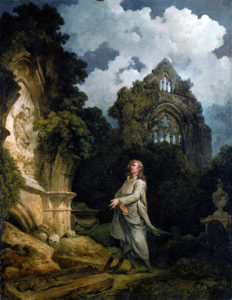
Tomorrow, the 25th of April, brings St. Mark’s Day, a day traditionally marked in many northern places by the arrival of migratory birds and with blessings uttered upon the newly sown crops of springtime. Things this year may seem somewhat delayed, but summer is coming, I promise, and St. Mark promises, too.
In Venice, a city watched over lovingly by St. Mark from the Basilica di San Marco, thousands of rosebuds will be exchanged, a custom emerging from an old story of love lost. It is a story easily imagined as a play within a play by the likes of someone like William Shakespeare, a little drama watched perchance by the lords and ladies of the larger tale, one which brings a heavy sigh and a gentle tear to those whose hearts are moved by touching stories. Here it is: In the eighth century, there lived in Venice a humble troubadour named Trancedi. He fell head over heels in love with the doge’s daughter, Maria, and Maria was equally enamored of the troubadour. The doge, however, was not pleased that a man of so low a social standing (a troubadour!) was wooing his daughter. And so Trancedi went off to prove his worthiness, off to war in a distant land, in hopes of returning triumphant, thereby impressing his potential future father-in-law. Through it all, Trancedi proved heroic, but, alas, just before he was to return home to Venice, he was mortally wounded in one last battle. His good friend Orlando rushed to his side as Trancedi fell, dying, upon a rose bush. And in his final moments on this earth, far from his intended, Trancedi plucked a single rosebud and gave it to his friend, asking him one last favor: to bring the flower to Maria. He did. She received the blood-stained bloom, and the news of her love’s fate, on St. Mark’s Day, the 25th of April, and that night, she died upon her own bed, holding Trancedi’s rosebud, a symbol of love eternal. And to this day, in memory of the troubadour and the doge’s daughter, rosebuds are exchanged in Venice on St. Mark’s Day.
For dinner on St. Mark’s Day, most Venetians will eat a simple dish: risi e bisi in the Venetian dialect: a risotto of rice and peas with pancetta and onion, in years past brought with great ceremony to the doge. Peas as a symbol of spring, rice for abundance. The day marks, as well, Liberation Day throughout Italy: the Festa della Liberazione. It is a national holiday, marking the day in 1945 that ended the Fascist regime and the Nazi occupation of Italy.
To the north, with St. Mark’s Eve at tonight’s sunset, things are focused less on romance and more on mystery, for St. Mark’s Eve is a traditional night of divination of varying types. There is a traditional spell for young folks to practice to help them see who their future mate might be, but keep in mind it harkens back to a time when folks did not lock their doors. The spell goes like this: Fast from sunset on St. Mark’s Eve and during the night, bake a cake that contains an eggshellfull of salt, wheat meal, and barley meal. Set the baked cake to cool on the table; sometime over the course of the night your future love will come and turn the cake. You’ll just need to stay awake to see who it might be.
There is as well an old tradition of divination by nuts on St. Mark’s Eve, much like the more famous Halloween divinations. Young women would set a row of nuts on the hot embers of the hearth, one for each girl. Each would breathe the name of her intended into the hearth and if the love was to be true, the nut would jump away as it got hotter. But if the nut sat there and was consumed by the fire, the love was not meant to be:
If you love me, pop and fly,
If not, lie there silently.
Ah, but these are divinations for matters of the heart and the most famous of St. Mark’s Eve divinations are not. No, more common in ages past, particularly in England and especially around Yorkshire, were divinations of a darker sort, more macabre: If your curiosities run in this direction, and if you’ve not already set the wheels in motion, you will need to begin now for a divination event that will occur three years from tonight. For this and for the next two St. Mark’s Eves you will need to fast and then spend the hours between 11 PM and 1 AM sitting on the porch of a church. Come the third year, in that witching hour, you should see a procession pass before you of the shadows of all who will die in the coming year, as this excerpt from a poem by James Montgomery suggests:
‘Tis now, replied the village belle,
St. Mark’s mysterious eve,
And all that old traditions tell
I tremblingly believe;
How, when the midnight signal tolls,
Along the churchyard green,
A mournful train of sentenced souls
In winding-sheets are seen.
The ghosts of all whom death shall doom
Within the coming year,
In pale procession walk the gloom,
Amid the silence drear.
If the poem sounds familiar, that’s because I give you those lines to read each year on this night. Montgomery’s poem is called “The Vigil of St. Mark” and it is based on old persistent folk customs. The churchyard watching is for two hours, and it is said that those apparitions, or wraiths, who enter the church in the early hours of the watch will die first; those who enter later, toward the end of the watch, will die later in the year. Those who approach the church and pause to gaze into the windows will become ill in the coming year, but they won’t die. It is said that some who have practiced the spell have seen their own wraiths––and that they have died within the year of their watch.
We don’t typically think of spring as a time of year for such dark interests, but there you have it. If you’ve been reading this Book of Days for any substantial amount of time, it’s probably quite obvious that I love a night of mystery. I have my theories about the traditions for St. Mark’s and why the darker ones come from a colder land, one where perhaps winter has a way of hanging on too long, manifesting, perhaps, in divinations and quiet tales told in whispers in darkness, the ones that cause neck hairs to bristle. But me, I’ll be sticking to the Italian ways for St. Mark’s. I’ll keep the day as one celebrating rice and peas and migratory birds and love. But then again I live in a place where spring has already made its triumphant arrival. For weeks now, we’ve been noticing the young chartreuse green of new leaves, and our annual litany of flowering trees has begun with the blooming of the citrus trees, with their unmistakable lovely perfume, followed by the Florida Lilac (which is not a tree but will happily vine up a tree) and the Tabebuia argentia (the Yellow Tabs, as we call them), and soon the Jerusalem Thorns, the Bottlebrushes, the Jacarandas, and by May, we’ll be enthralled with the flaming reds of the Royal Poinciana. But by then we’ll know that summer has arrived. For now, the bright yellow of the Tabebuias is all we need, together with the near perfect weather, not too hot, not too cold, to know that spring has come.
Image: Florida Lilac abloom just outside Seth’s new pottery studio.



